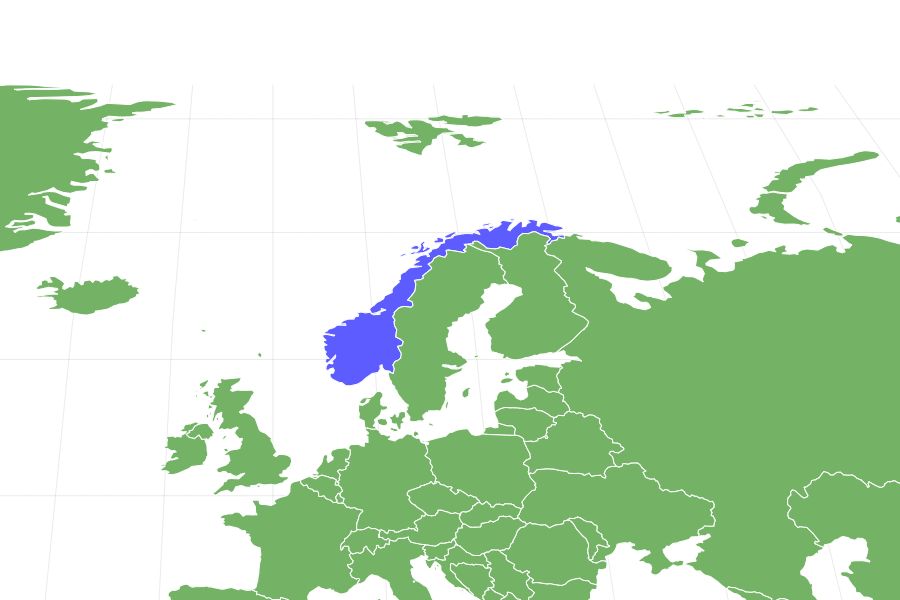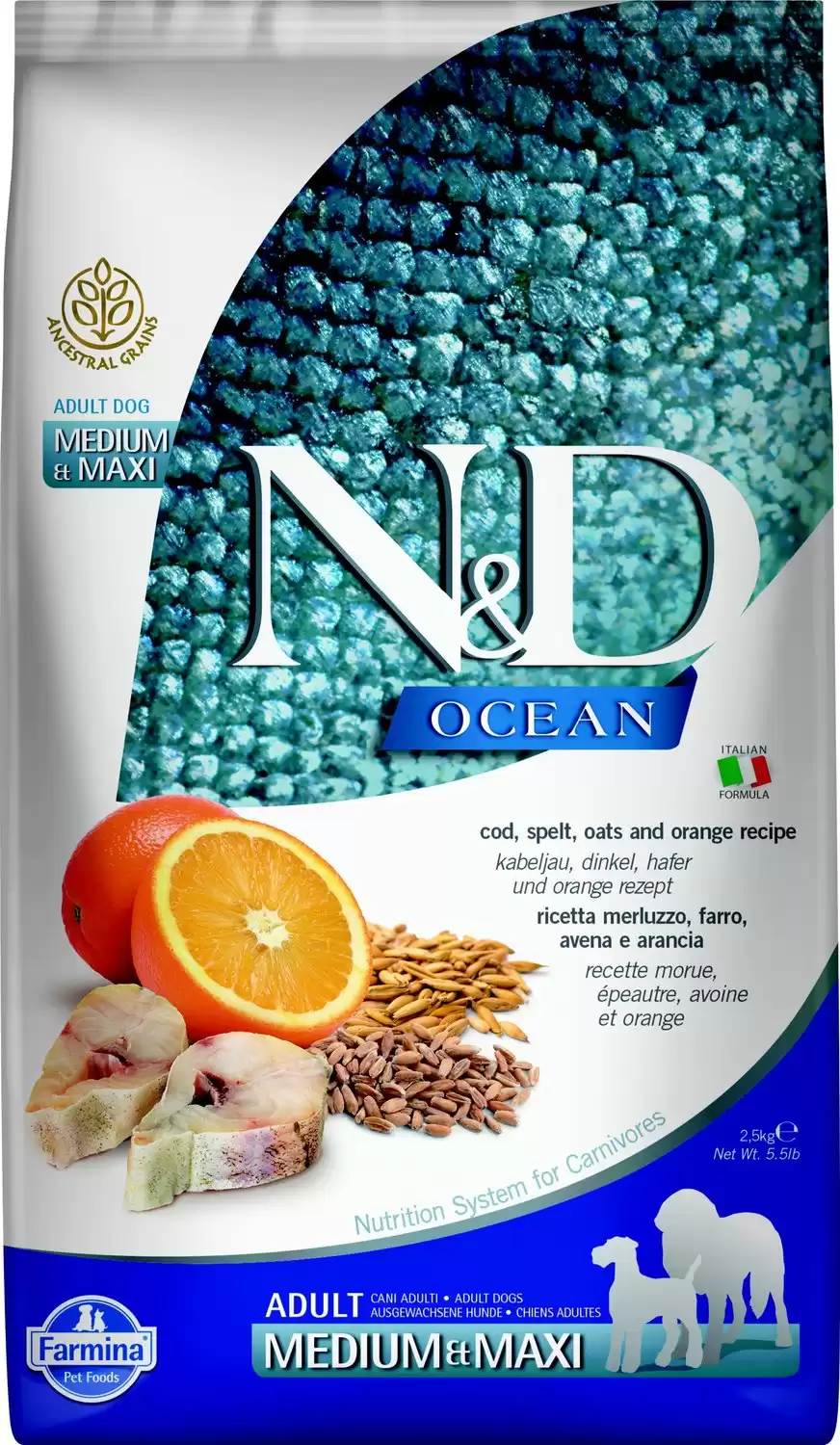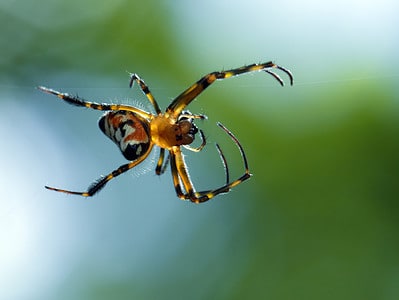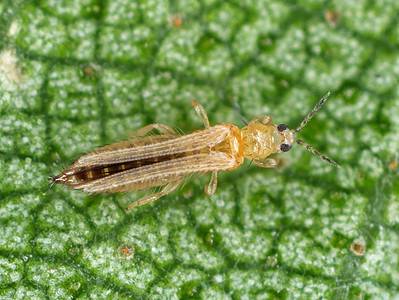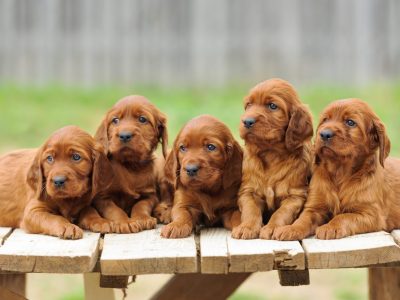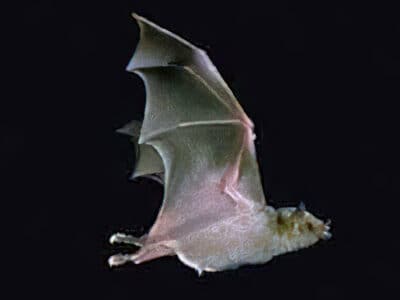Norwegian Elkhound
Canis lupus
This breed traveled with the Vikings!
Advertisement
Norwegian Elkhound Scientific Classification
- Kingdom
- Animalia
- Phylum
- Chordata
- Class
- Mammalia
- Order
- Carnivora
- Family
- Canidae
- Genus
- Canis
- Scientific Name
- Canis lupus
Read our Complete Guide to Classification of Animals.
Norwegian Elkhound Conservation Status
Norwegian Elkhound Facts
- Fun Fact
- This breed traveled with the Vikings!
- Distinctive Feature
- A double coat that sheds dirt and is weather-resistant.
- Temperament
- Strong-willed, loyal, playful
Norwegian Elkhound as a Pet:
- General Health
- Energy Level
- Shedability
- Trainability
- Intelligence
- Tendency to Chew
- Size
- Family and kid friendliness
- Yappiness / Barking
- High
- Separation Anxiety
- Moderate
- Preferred Temperature
- Cold climate
- Exercise Needs
- Moderate
- Friendly With Other Dogs
- Moderate
- Pure bred cost to own
- $500-$1500
- Dog group
- Hound
- Male weight
- 50-60 lbs
- Female weight
- 40-55 lbs
This post may contain affiliate links to our partners like Chewy, Amazon, and others. Purchasing through these helps us further the A-Z Animals mission to educate about the world's species.
View all of the Norwegian Elkhound images!
Images of these dogs have appeared in ancient Norse artwork. Besides that honor, these dogs also made their way into early Viking legends.
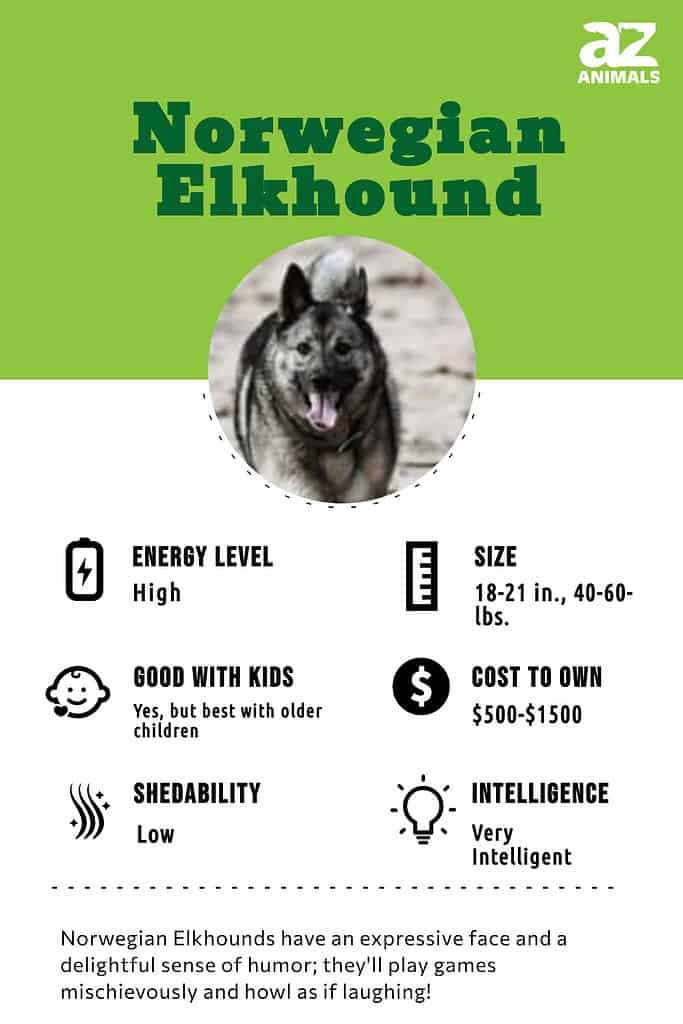
Norwegian Elkhounds are one of the oldest dog breeds in Europe, perhaps in existence for thousands of years. They were used as hunting and guard dogs by the Vikings. Not a Hound, despite the name, they are part of the Spitz group. In Norwegian, “elg” means moose and “hund” means any dog. So they may have helped hunt elk, but they were more commonly used to hunt moose. They can smell game from over a mile away.
See all of our expert product reviews.
These dogs are agile, alert, and always ready for adventures with their families. In addition to being fun family companions, they are also accomplished watchdogs. Further, they are part of the Hound group and were favorite hunting companions for the Vikings.
These dogs are always ready to join any adventure. They are sensitive to their owners, yet strongly independent. The dogs are perfect for family activities and have a longer lifespan. Although there are no hybrid varieties of this breed, there are several color options from black to silver that help provide various looks.
3 Pros and Cons of Ownership
| Pros | Cons |
|---|---|
| A fairly compact breed: This breed rarely exceeds 50 to 60 lbs, making their size compact for a hunting breed. Because they are not as large as some similar dogs, they are relatively easy to manage on a leash once trained. | Adjusts to other pets with difficulty: Norwegian Elkhounds will require some time to adjust to other animals and usually want to be the dominant dog. Although they usually make friends with other dogs, they are not cat fans! |
| They love people: These dogs are loyal to and bond closely with the whole family. These dogs relish getting plenty of attention and won’t pass up snuggling opportunities. | A high fence-jumper: Norwegian Elkhounds can get over six-foot fences quickly, despite their shorter height. Supervision is necessary to keep these dogs from going out on an adventure. |
| Perfect dogs for active owners: Norwegian Elkhounds have an energy level that keeps them in an almost constant state of motion. If you enjoy activities that take you out into the great outdoors, your dog will be happy to on you. | A very loud breed: Norwegian Elkhounds can be very loud. These dogs won’t make the distinction between barking at game in the field or barking at a passing postal carrier while in the house. |
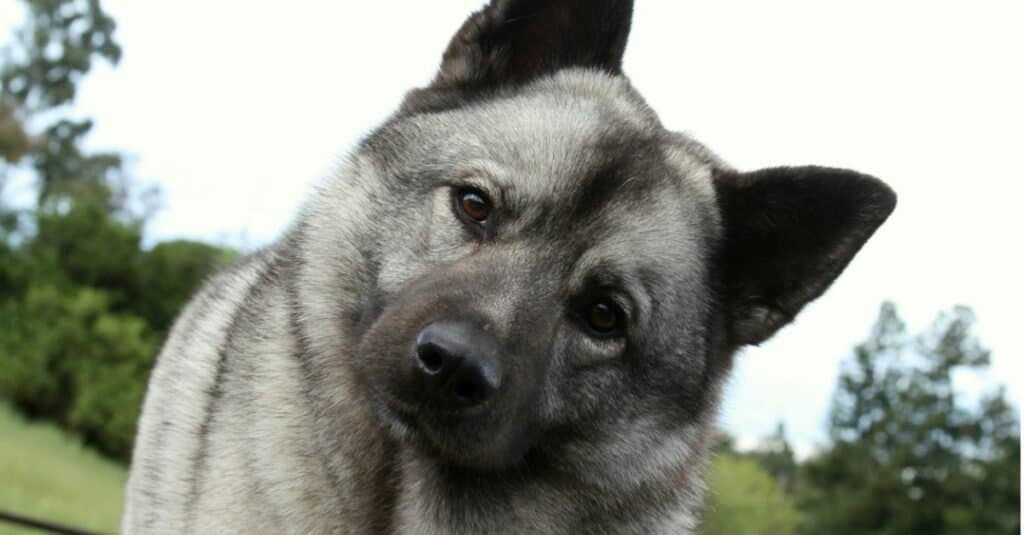
©Sheryl Lynch/Shutterstock.com
Size and Weight
The Norwegian Elkhound is considered a medium-sized dog, with male height averaging 20 inches and female height averaging 19 inches. The average weight is 55 lbs. for males and 48 lbs. for females. The size is consistent with the average lifespan.
| Height (Male): | 19-21 inches |
| Height (Female): | 18-20 inches |
| Weight (Male): | 50-60 lbs |
| Weight (Female): | 40-55 lbs |
Common Health Issues
This breed has a few health issues that can come at a high price to treat. Hip dysplasia is one of the most common health issues that these dogs live with, a painful condition affecting mobility. Progressive retinal atrophy is a condition that can affect the eyes. Norwegian Elkhounds may also be susceptible to autoimmune hypothyroidism. Fanconi syndrome, a type of kidney disease, and skin cysts are also conditions that these dogs are vulnerable to. Getting a dog from a responsible breeder that screens for problems with the heart and eyes may help decrease the chances of your pet developing these problems. In short, the most common health issues that Norwegian Elkhounds face are:
Health and Entertainment for your Norwegian Elkhound
See all of our expert product reviews.
- Hip dysplasia
- Progressive retinal atrophy
- Autoimmune hypothyroidism
- Fanconi syndrome
- Skin cysts
Temperament
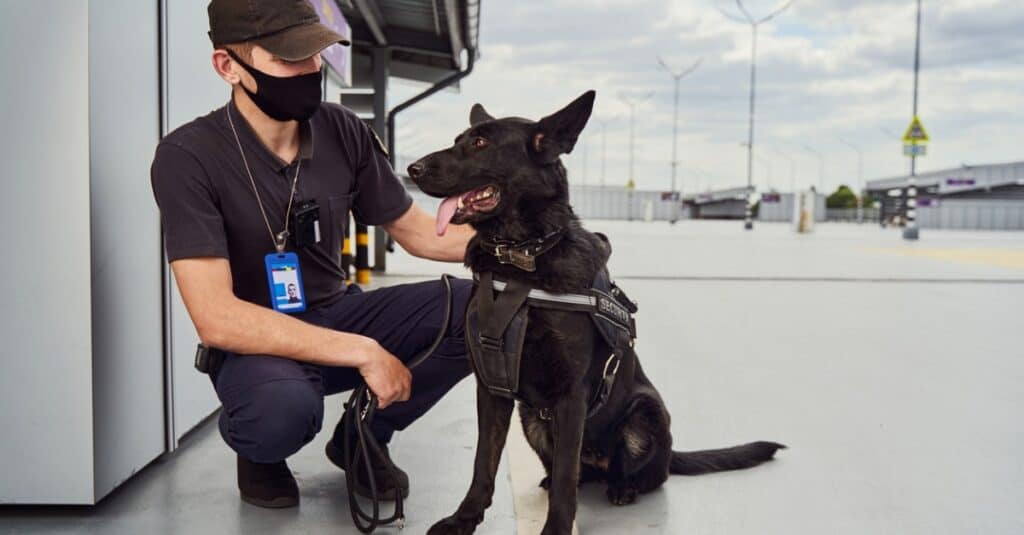
Extroverted, and always wanting to be in on the action, a Black Norwegian Elkhound is good at Airport Security work.
©iStock.com/Svitlana Hulko
From the time they are puppies, this breed is naturally extroverted, independent, protective, and loyal. These dogs are always happy to be in on the action, with a temperament that embodies its fun-loving nature and a mischievous gleam in its eyes. This breed has a strong independent streak, which can make training a little bit tricky at times.
Norwegian Elkhounds are protective, not letting even perceived threats bother their families without a fight. Although not aggressive, they have a bark that is usually enough to encourage a would-be intruder to stay away. These dogs are loyal to their families, without question, and develop strong bonds with all family members.
Care
There are several important considerations for new Norwegian Elkhound owners to keep in mind, regardless of whether they have dogs from a breeder or rescue dogs. Breed-specific issues may range from maintaining an ideal weight to whether a black coat color requires special care to which conditions your vet should screen for in the dog during exams.
Best Dog Food
Norwegian Elkhounds, including puppies and adults of all lifespan stages, have unique needs because of their playful nature. The food that you pick will need to address the dog’s individual needs ranging from its teeth to its coat. At periodic appointments, collaborate with your vet to come up with the ideal diet for your dog. This breed can exhibit kidney disease, in which case, many vets recommend low-phosphorus dog food.
Puppy food: Puppies of this breed thrive on diets with a high ratio of amino acids for a stronger immune system. Foods rich in protein help their muscles grow strong. Lean meats, such as fish or chicken, can help easily meet growing puppies’ needs, especially for healthy teeth and bones.
Adult dog food: Foods high in amino acids and protein will be necessary for adults as well. Hybrid blends of freeze-dried meat and dry food are among some of the most popular food types. Any food that these dogs eat should have meat as the first ingredient.
At A-Z Animals, we feel the best dog food for Norwegian Elkhounds is Farmina Natural & Delicious Ocean Ancestral Grain Cod & Orange Adult Medium & Maxi Dog Food.
This recipe is a perfect match for this breed, not just because it contains Scandinavian herring, but because of its full nutritional profile. Using fish as a source of protein, the formula includes glucosamine for resilient joints, and taurine and beta-carotene, both of which promote healthy eyes.
Here’s where you can get Farmina N&D Ocean Ancestral Grain and Cod dog food on Chewy or Amazon.
- The #1 ingredient in this high protein, limited carbohydrate, and low fiber all life stage dog food is cod.
- 90% of protein is from quality animal sources.
- It's a low glycemic formula so it's a great option for pets that need a food that won't spike blood sugar.
- Contains no whole peas, legumes, meals or by-products.
- Food vitamins retain their freshness through a coating system that allows them to be included post cooking.
Maintenance And Grooming
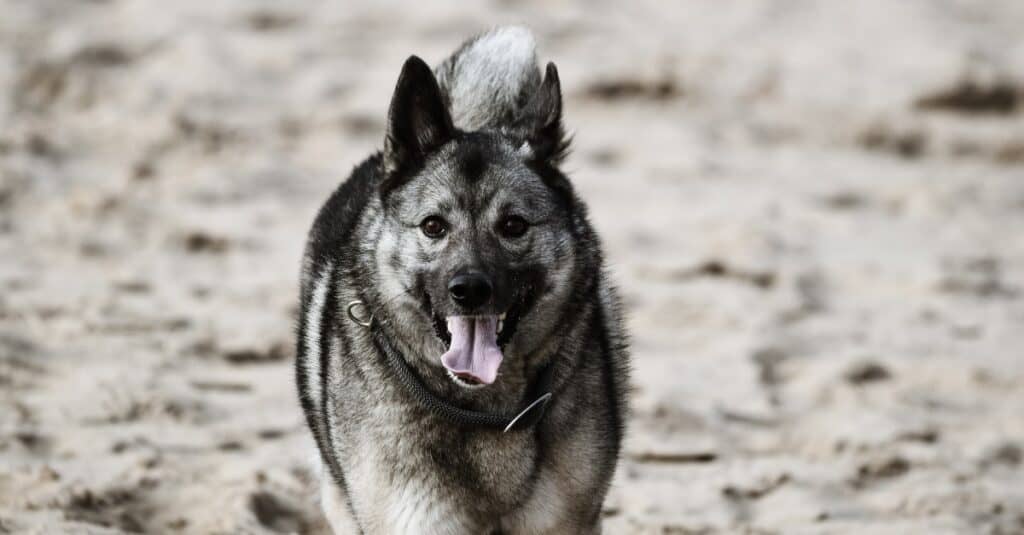
Norwegian Elkhounds are high energy, but low shedders and relatively easy to train despite a strong independent streak.
©iStock.com/Darius Murawski
Norwegian Elkhounds do not shed much but blow their coats two or three times yearly, often leading to clumps of black or silver hair around the house. Brushing once or twice a week and bathing the dog every six months will help keep the coat clean. Dog brushes with stiff bristles will get through the dog’s hair quickly. Aside from skin cysts, these dogs generally have no significant coat or skin conditions.
Training
These dogs are very intelligent, with a strong independent streak. However, they are relatively easy to train when using reward-based methods. Treats are some of the most popular rewards.
Exercise
Norwegian Elkhounds require vigorous activity daily because of their natural energy level. Because of the breed’s activity level and loud bark, these dogs are better suited to houses with yards than to apartments. At least a walk a day is recommended. Running shorter distances in enclosed areas and playing fetch are examples of activities that are ideal for these dogs, including hybrid activities like combining fetch with a good long run.
Puppies
Although not as common in rescue as many other breeds, finding a Norwegian Elkhound puppy through a rescue is possible. Because these dogs are so high-energy, they are often a poor fit for people without the time to devote to the dog’s training. These puppies, in particular, love to get their teeth on anything within easy reach. Sometimes, owners who acquire one of these dogs are unwilling to devote the time to training or pay the price of a trainer.
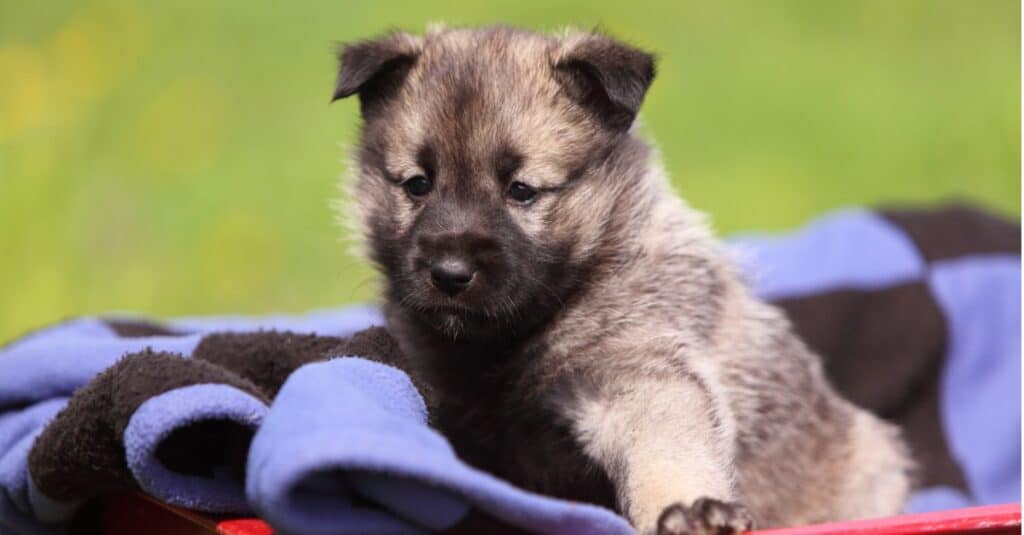
©iStock.com/JLSnader
Children
Although these are loyal family dogs, they are not necessarily suited to people of all ages. These dogs are often somewhat rough in their play, increasing the chances of injuring a small child. The breed does best with older children and teens.
Similar Dogs
Similar dog breeds to the Norwegian Elkhound include the Finnish Spitz, German Spitz, and Japanese Spitz.
- Finnish Spitz – Shares a love of elk hunting, a loud bark, and playful nature with the Norwegian Elkhound. This dog is somewhat smaller in size, however.
- German Spitz – A smaller alternative, the German Spitz shares the thick coat , watchdog traits, and thick coat with Norwegian Elkhounds, as well as a similar color.
- Japanese Spitz – Also a smaller alternative to the Norwegian Elkhound, the Japanese Spitz shares strong family loyalty, a fluffy coat, and an athletic build.
Famous
The most famous Norwegian Elkhound was President Herbert Hoover’s dog, Weeje, who lived with him at the White House during the 1930s. An “X-Files” episode mentions a Norwegian Elkhound that a character owns. The breed also appears in When Christ and His Saints Slept by Sharon Kay Penman and Orlando: A Biography by Virginia Woolf.
Popular Names for Norwegian Elkhound
- Odin
- Thor
- Fenrir
- Freya
- Mist
- Grendel
- Pearl
- Spirit
- Wolf
- Moonlight
Norwegian Elkhound FAQs (Frequently Asked Questions)
How much does Norwegian Elkhound cost to own?
The purchase price of a Norwegian Elkhound is $1,260 to $6,000 or more, with annual costs ranging from $1,000-$2,000
Is Norwegian Elkhound good with kids?
Norwegian Elkhounds do well with children. They are very loyal. Though they may be reserved around strangers, they are eager to greet family members and other people they know.
How long does Norwegian Elkhound live?
Norwegian Elkhounds live an average of 12-15 years.
What's the difference between a Norwegian Elkhound and an Akita?
The Akita grows far larger than the Norwegian Elkhound. Additionally, the Norwegian Elkhound originated in Europe, while the Akita orginated in Japan.
What's the difference between Norwegian Elkhounds and German Shepherds?
German Shepherds are larger than Norwegian Elkhounds, and they also have longer ears and noses. Additionally, Norwegian Elkhounds are an ancient dog breed from Europe, while the German Shepherd originated in Germany during the 1800s.
Thank you for reading! Have some feedback for us? Contact the AZ Animals editorial team.
Sources
- American Kennel Club, Available here: https://www.akc.org/dog-breeds/norwegian-elkhound/
- Your Purebred Puppy, Available here: https://www.yourpurebredpuppy.com/reviews/norwegianelkhounds.html
- Embrace Pet Insurance, Available here: https://www.embracepetinsurance.com/dog-breeds/norwegian-elkhound
- Dog Time, Available here: https://dogtime.com/dog-breeds/norwegian-elkhound#/slide/1
- Breed Advisor, Available here: https://breedadvisor.com/best-dog-food-for-norwegian-elkhound/
- Montana Mountain Elkhounds, Available here: https://www.mtmountainelkhounds.com/about-norwegian-elkhounds
- Hill's Pet, Available here: https://www.hillspet.com/dog-care/dog-breeds/norwegian-elkhound
- Life in Norway, Available here: https://www.lifeinnorway.net/norwegian-elkhound/
- Dog Temperament, Available here: https://www.dogtemperament.com/norwegian-elkhound-price-cost/
- Pet Helpful, Available here: https://pethelpful.com/dogs/Great-Names-for-Your-Norwegian-Elkhound

